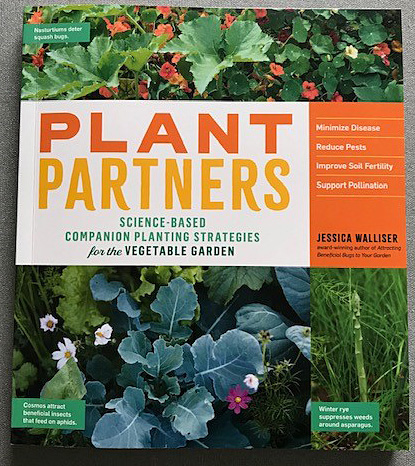Book Review: Plant Partners

Plant Partners: Science-Based Companion Planting Strategies for the Vegetable Gardener by Jessica Walliser (Storey Publishing, 2020, 206 pp., $24.95)
by Susan Mulvihill
Many gardeners are familiar with the concept of companion planting: some plant combinations promote better growth and production while others inhibit these desirable outcomes. Or do they?
A long time ago, I read Carrots Love Tomatoes by Louise Riotte, as I was eager to learn these tips in my quest to become a successful vegetable gardener. But the more I thought about it, and the more experienced I became, I realized there were too many variables involved. Did the plant combinations do well because of the weather? The nutrients in the soil? The amount of sunlight or moisture they received? Or was there something to this idea of companion planting?
Fortunately, author Jessica Walliser had been wondering about this, too, and wanting to share what she learned through all of her research. The result is her latest book, Plant Partners. She is a prolific writer and highly-respected horticulturist. My favorite two books have been Good Bug Bad Bug and Attracting Beneficial Bugs to Your Garden.
In Plant Partners, Jessica focused on how certain combinations of plants to help loosen heavy soils, attract good bugs, drive pests away (or at least confuse them), fight plant diseases and weeds, and improve pollination.
As she writes, “Modern companion planting isn’t about what plant “loves” growing next to what other plant. It’s about using plant partnerships to improve the overall ecosystem of the garden and create a well-balanced environment in which all organisms thrive, from the tiniest soil microbe to the tallest corn plant. It’s about pairing plants such that one plant provides a benefit to the other in terms of an ecosystem service.”
In chapter 1, “The Power of Plant Partnerships,” Jessica explains how they can share resources, impact how readily other plants are able to take up nutrients, communicate with each other via chemical signals (semiochemicals) or via mycorrhizal fungi, and through allelopathy (the release of chemicals that impact a nearby plant’s ability to grow). She encourages us to plant our gardens with diverse plants to promote a healthy ecosystem.
Within chapter 2, “Soil Preparation & Conditioning,” she underscores how important it is to avoid tilling or disturbing the soil because this impacts the fungi that help our plants in so many ways. Instead, Jessica recommends adding mulch to the soil surface. She advocates the use of cover crops to benefit a subsequent planting and provides plenty of information to ensure success with these marvelous, temporary crops. Readers will find plant partnerships between leguminous (such as beans and peas) and vegetables that require a lot of nitrogen in order to grow.
Weed management is covered in chapter 3, through the use of living mulches and allelopathy. All of this is so fascinating and I love how she gives examples of plant partnerships that work well.
I particularly enjoyed chapter 4, “Support & Structure,” where the author suggests pairing a sturdy, upright plant with a vining one to create a living trellis. While she admits this topic isn’t necessarily a “traditional companion planting strategy,” it’s something we gardeners should employ more. Jessica offers 12 suggestions for this to get our creative juices flowing.
Readers will find chapter 5 especially helpful: “Pest Management: Luring, Trapping, Tricking, and Deterring Pest Insects.” The underlying premise is to plant diverse landscapes rather than monocultures. Jessica presents the scientific evidence behind certain companion planting strategies. There’s an intriguing section on how pests find host plants using visual and/or chemical cues. It turns out some companion plants aren’t repelling insects but rather, masking the scent of host plants. By planting “trap crops” to lure pests to sacrificial plants away, or interplanting other types of plants with a crop, it’s possible to thwart pest problems. The author gives examples of plant pairings to protect host plants from some particularly nasty pests.
In chapter 6, “Disease Management,” readers will find helpful tips for keeping plants healthy through the use of cover crops, certain plant partnerships, and planting in layers to improve air circulation around by plants.
For chapter 7, “Biological Control,” Jessica explored the problems of releasing non-native predators in the hope of controlling pests versus conservation biocontrol where you encourage and assist beneficials within your own landscape by avoiding the use of pesticides and nurturing plants that provide nectar and pollen. Once again, the author suggests pairings of crops with other plants to keep beneficials nearby when problems arise or adding plants that provide habitat for beneficials.
Yes, there’s even more! In chapter 8, “Pollination,” Jessica explains what we can do to support and encourage native bees to increase pollination in our gardens. She provides lists of companion plants to attract pollinators and those with different flower types to help attract specific pollinators to certain crops.
In the back of the book, readers will find resources for both cover crop and living mulch seeds, a glossary of terms, and – most importantly – an impressive, detailed bibliography to help you delve into the many studies Jessica cited so you can learn more.
It’s so refreshing to finally have a research-based book on companion planting! Plant Partners is a great guide that will help you succeed in your garden.

